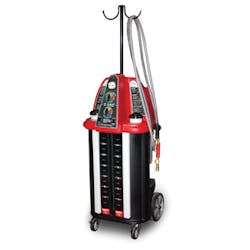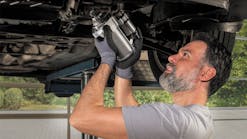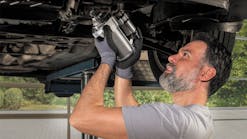Dozens of studies, surveys and news reports have told us that consumers are following their preventative maintenance service schedules closer as they let their cars age and put off buying new cars. That means now is a great time to look to add to your preventative maintenance menu. One idea to add is coolant exchange as spring rolls in, and there are several machines on the market to help you.
But, when it comes to coolant exchange machines for your shop, do you know what to look for? Or, more importantly, do you know what you want?
“First thing a shop owner should consider is what level of service do they want to offer,” said Geoff Preston, marketing manager for MotorVac Technologies Inc. “The amount of fluid removed and the time it takes the unit to do it, are two pretty important features because a shop must perform the service quickly and effectively.”
Shop owners need to figure out if they are looking to do full-service flush/exchanges or simply a much quicker vacuum exchange of fluids.
Machine types
Today “ the majority of machines on the market are ‘engine-off process,’ ” said Frank Casale, director of sales and marketing for Flo-Dynamics. “It speeds up the entire service process.”
“The quick vac-and-fill basically just gets the fluid out of the radiator itself and then refills it,” Casale said. “This process is just done through the mouth of the radiator and is a quick three- to four-minute process.”
Manufacturers estimate the less-expensive vacuum machines will exchange about 60 percent to 70 percent of the coolant.
There will be “anywhere from about $300-$500, or possibly $1,000, in price difference between the two types of machines,” said Ralph Vergara, auto sales manager for Ritchie Engineering.
“The vacuum-exchange machines are a much lower price point, they’re faster and there are no connections to be broken,” Vergara said.
“The other service that’s being performed is a full flush — connect to the upper radiator hose, plumb in your lines and, with the engine off, you can do a complete flush in about five minutes once you’re connected,” Casale said.
Preston said other advantages of the full-flush machine include “complete control” and “a clean, ‘environmentally friendly’ and systematic approach to servicing cooling systems.”
“Full-service shops are looking for machines with flush capabilities,” Vergara said.
Important features
Casale said shops should look for a machine that can drain down the system for component changes. “Drain it down, change the water pump, do a vacuum fill and have the customer off and going.”
He also suggested a machine that can do pressure tests is important, as well as have multiple tanks.
Each manufacturer suggested multiple tanks are very important as OEMs have several different approved coolant types.
The size of the containers are also key, as larger capacity will certainly help with service on SUVs and trucks, said Vergara. He also said pressure testing is important, as well as a larger waste container for less time spent emptying old fluids.
Another feature of convenience, Vergara said, is a machine that runs off shop air vs. 12V power, which makes setup in different areas of the shop easier.
Preston said that several keys features to look for include:
• Static or dynamic fluid exchange
• One switch, multi-function operation
• Complete flow synchronization for 1:1 fluid exchange
• Front panel controls for all machine functions with pressure gauge and warning lights
• Industrial grade radiator hoses and adapters to service most vehicles
“Marketing support is also a key feature of a unit,” said Preston. “Manufacturer support and making POS materials available is important because they help the installer explain the benefits of the service to the consumer, which results in increased sales and increased customer satisfaction.
“Technical support is often an overlooked feature that shops should also consider in case they get into a tight spot and need help fast,” he said.


